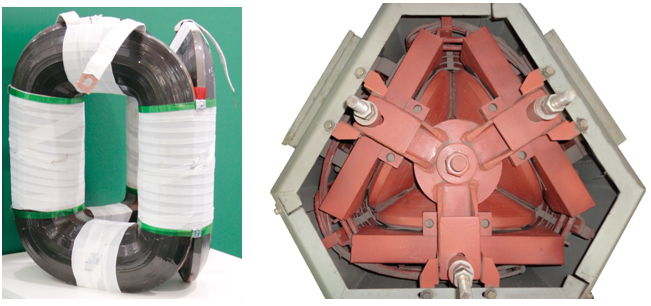Improving the main indicators of transformers with twisted one-piece magnetic cores by changing the technology of circular winding turns formation
DOI:
https://doi.org/10.20998/2074-272X.2022.3.01Keywords:
twisted transformer, one-piece magnetic core, insulating frame, coil, windingAbstract
Introduction. With the adoption of standards to reduce losses in transformers it is necessary to change the design of transformers that remain unchanged. Further energy saving is possible with the use of non-traditional technical solutions for the improvement of transformers. Problem. In order to reduce idle losses, the curved magnetic circuits of power transformers are carried out in the form of low-volume circuits. Windings are injected into assembled magnetic conductors by shuttle machines. The shuttle of windings provides technological gaps in winding windows, which results in an increase in size, metal capacity and losses. Goal. Rationale for transformer performance improvement by excluding process gaps in winding windows. Methodology. The definition of the change in transformer indicators is performed using optimization functions of the dimensionless indicators of the technological level. The adequacy of the functions is confirmed by the calculation of the mass of the electromagnetic system and the losses of the transformer. The figures of the compact analogue are calculated from the named serial analogue. Results. The result is a reduction in mass and a loss in the compactness of the transformer. Originality. The improvement of the indicators and the simplification of the winding technology are provided by a change in the design of insulating frames of winding coils. Winding on the rods is ensured by rotating the outer part of the composite insulating frame. Practical significance. Replacement the design of the windings of transformer with power of 40 kVA of 1000 V voltage class with a spatially twisted, small-dimensional magnetic conductor on a compact analogue leads to a reduction in mass and overall dimensions by 15 % and (17-18) %. Efficiency increases by 0.3 %.
References
Kostinskiy S.S. The review of the condition of branch of transformer manufacture and tendencies of development of the design of power transformers. Izvestiya Vysshikh Uchebnykh Zavedenii. Problemy Energetiki, 2018, vol. 20, no. 1-2, pp. 14-32. (Rus). doi: https://doi.org/10.30724/1998-9903-2018-20-1-2-14-32.
Targosz R., Topalis F.V. Energy efficiency of distribution transformers in Europe. 2007 9th International Conference on Electrical Power Quality and Utilisation, 2007, pp. 1-5. doi: https://doi.org/10.1109/EPQU.2007.4424121.
De Almeida A., Santos B., Martins F. Energy-efficient distribution transformers in Europe: impact of Ecodesign regulation. Energy Efficiency, 2016, vol. 9, no. 2, pp. 401-424. doi: https://doi.org/10.1007/s12053-015-9365-z.
Charalampopoulos C., Psomopoulos C.S., Ioannidis G.Ch., Kaminaris S.D. Implementing the EcoDesign Directive in distribution transformers: First impacts review. AIMS Energy, 2017, vol. 5, no. 1, pp. 113-124. doi: https://doi.org/10.3934/energy.2017.1.113.
Innovative breakthrough in the power transformer market. (Rus). Available at: http://www.elec.ru/articles/innovacionnyc-proryv-na-rynke-silovyh-transformatorov (Accessed 24 March 2021).
Stavinskii A.A., Avdeyeva Y.A., Pal’chikov O.O., Stavinskii R.A. The Generalized Method for Structural-Parametric Synthesis of the Electromagnet Systems of Electrical Machines and Induction Apparatuses. Part 1. Results from a Comparative Analysis of Different Versions of Three-Phase Transformer Electromagnet Systems. Elektrichestvo, 2017, vol. 4, pp. 39-49. (Rus). doi: https://doi.org/10.24160/0013-5380-2017-4-39-49.
Almen J., Breitholtz M. Performance evaluation of amorphous hexa-core for distribution transformers. Bachelor’s Thesis in Electric Power Engineering. Chalmers University of Technology, Gothenburg, Sweden 2012. 50 p. Available at: https://publications.lib.chalmers.se/records/fulltext/167013.pdf (Accessed 20 March 2021).
Najafi A., Iskender I. Comparison of core loss and magnetic flux distribution in amorphous and silicon steel core transformers. Electrical Engineering, 2018, vol. 100, no. 2, pp. 1125-1131. doi: https://doi.org/10.1007/s00202-017-0574-7.
Kefalas T. Transformers Made of Composite Magnetic Cores: An Innovative Design Approach. Recent Patents on Electrical Engineering, 2009, vol. 2, no. 1, pp. 1-12. doi: https://doi.org/10.2174/1874476110902010001.
Kefalas T.D., Kladas A.G. Development of Distribution Transformers Assembled of Composite Wound Cores. IEEE Transactions on Magnetics, 2012, vol. 48, no. 2, pp. 775-778. doi: https://doi.org/10.1109/TMAG.2011.2172976.
Kefalas T.D., Magdaleno-Adame S. Techno-economic comparative evaluation of mixed and conventional magnetic wound cores for three-phase distribution transformers. Electric Power Systems Research, 2018, vol. 155, pp. 331-339. doi: https://doi.org/10.1016/j.epsr.2017.11.003.
Hernandez I., Olivares-Galvan J.C., Georgilakis P.S., Canedo J.M. A Novel Octagonal Wound Core for Distribution Transformers Validated by Electromagnetic Field Analysis and Comparison With Conventional Wound Core. IEEE Transactions on Magnetics, 2010, vol. 46, no. 5, pp. 1251-1258. doi: https://doi.org/10.1109/TMAG.2010.2040623.
Avdieieva E A., Stavinskiy R.A. Mass and cost figures for spatial axial three-phase electromagnetic systems with circular and hexagonal forming contours of twisted magnetic core rods. Electrical Engineering & Electromechanics, 2014, no. 1, pp. 15-20. doi: https://doi.org/10.20998/2074-272X.2014.1.02.
Avdieieva E.A., Stavinskiy R.A. Watt loss in three-phase transformers with circular and hexagonal forming contours of twisted spatial magnetic core rods. Electrical Engineering & Electromechanics, 2014, no. 2, pp. 14-17. doi: https://doi.org/10.20998/2074-272X.2014.2.02.

Downloads
Published
How to Cite
Issue
Section
License
Copyright (c) 2022 O. А. Avdieieva, L. V. Vakhonina, O. S. Sadovoy, R. A. Stavinskiy, O. M. Tsyganov

This work is licensed under a Creative Commons Attribution-NonCommercial 4.0 International License.
Authors who publish with this journal agree to the following terms:
1. Authors retain copyright and grant the journal right of first publication with the work simultaneously licensed under a Creative Commons Attribution License that allows others to share the work with an acknowledgement of the work's authorship and initial publication in this journal.
2. Authors are able to enter into separate, additional contractual arrangements for the non-exclusive distribution of the journal's published version of the work (e.g., post it to an institutional repository or publish it in a book), with an acknowledgement of its initial publication in this journal.
3. Authors are permitted and encouraged to post their work online (e.g., in institutional repositories or on their website) prior to and during the submission process, as it can lead to productive exchanges, as well as earlier and greater citation of published work.




